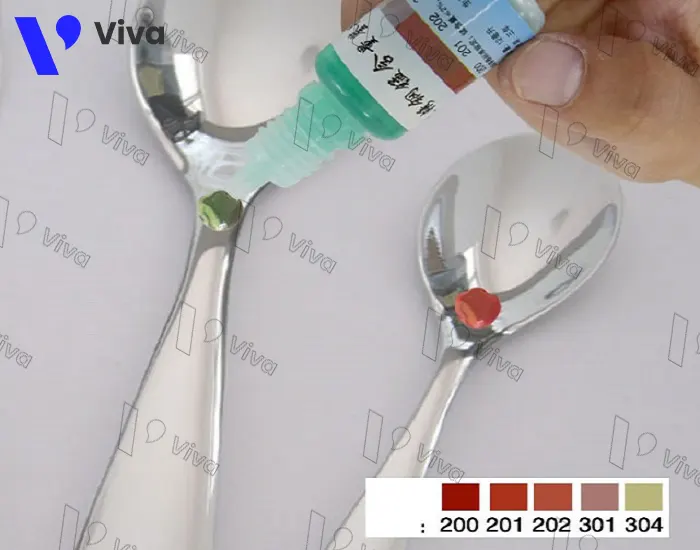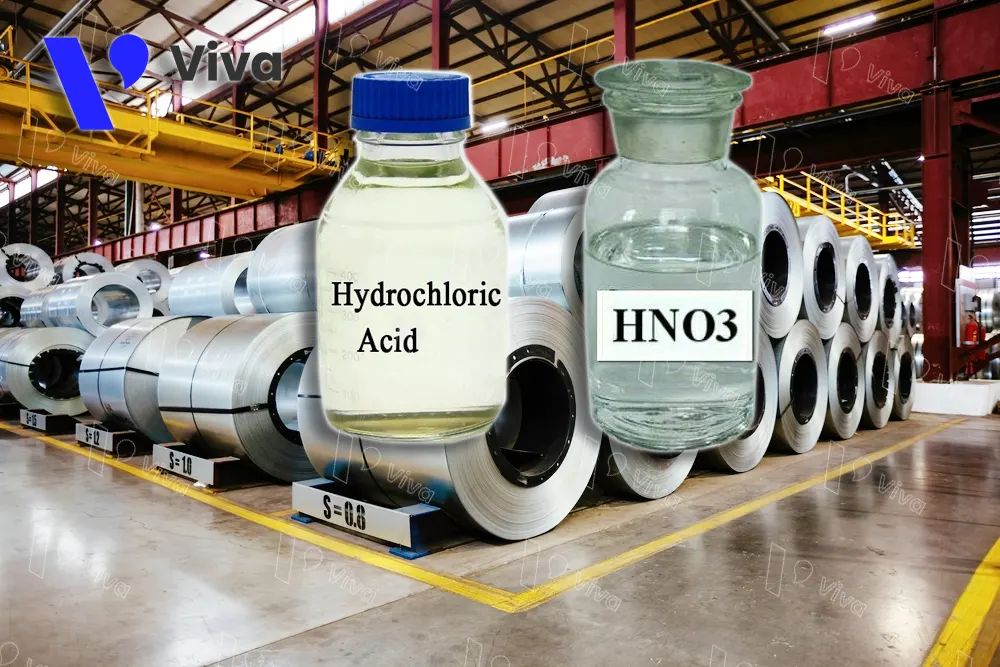How to distinguish between stainless steel types 304 and 201
Inox is a type of material widely used in the production of household products, industrial equipment, construction, and many other fields. Among them, stainless steel 304 and stainless steel 201 are the most commonly used. However, not everyone has enough knowledge to distinguish between these two types of stainless steel. In this article, we will explore and learn about simple and understandable ways to recognize and differentiate between stainless steel 304 and stainless steel 201.
How to visually distinguish stainless steel 304 and stainless steel 201

Differentiating between stainless steel 304 and stainless steel 201 visually is challenging because these two types of stainless steel have similar colors and surface appearances. However, below are some characteristics that you can observe to help differentiate between the two:
Color: Stainless steel 304 usually has a whiter silver color than stainless steel 201, but it is difficult to distinguish when they are galvanized or painted.
Shine: Stainless steel 304 has a higher shine and smoother surface than stainless steel 201. If you compare the two stainless steel samples on the same surface, stainless steel 304 will have a higher shine and smoother surface.
Thickness: Stainless steel 304 is usually thicker than stainless steel 201. However, visually distinguishing them is challenging because the difference in thickness is not significant.
Surface: Stainless steel 304 typically has a shinier, smoother, and more beautiful surface compared to stainless steel 201, while stainless steel 201 has a rougher surface and less shine.
Distinguishing stainless steel 304 and stainless steel 201 using a magnet

The method of distinguishing between stainless steel 304 and stainless steel 201 using a magnet is a simple and commonly used method. The steps are as follows:
- Prepare a magnet: Use a magnet with strong magnetic properties for the test.
- Prepare samples: Take samples of stainless steel 304 and stainless steel 201, making sure to take samples from different positions on the products to ensure representativeness.
- Use the magnet: Bring the magnet close to the stainless steel sample and observe the phenomenon.
- If the magnet does not stick or only sticks lightly to the stainless steel sample, it can be determined as stainless steel 201.
- If the magnet strongly sticks to the stainless steel sample, it can be determined as stainless steel 304.
However, this method is only a qualitative method and does not guarantee 100% accuracy.
Using specialized testing agents
Specialized stainless steel testing agents are available on the market. We purchase them and proceed with the testing.

Clean the surface to be tested, especially from oil and grease. If the stainless steel has a coating, remove the coating layer. Apply a drop of testing agent on the surface and wait for 2-3 minutes. Observe the color change and compare it with the color chart on the packaging to determine the type of stainless steel:
- Stainless Steel 201 (Standard 201) turns red within approximately 50 seconds.
- Stainless Steel 304: No color change within 3 minutes.
The testing time should be limited to a maximum of 3-5 minutes. In some cases, leaving the testing agent for a few hours or even a whole day can cause the solution to change color, including for stainless steel 304, leading to inaccurate results, confusion, and misjudgment of the product. If the weather is too cold, preheat the test surface for about 3-6 seconds.
Using chemicals to differentiate between inox 304 and 201

We can use the following chemicals to differentiate between these two types of stainless steel:
Nitric acid (HNO3): Stainless Steel 201 contains manganese (Mn) in its chemical composition. When it comes into contact with nitric acid, manganese will create a yellow-colored layer on the surface. On the other hand, Stainless Steel 304 does not contain manganese, so it is not affected.
Hydrochloric acid (HCl): Stainless Steel 304 contains iron (Fe) in its chemical composition. When it comes into contact with hydrochloric acid, iron will create an orange-yellow layer on the surface. In contrast, Stainless Steel 201 contains less iron, so it is not affected.
However, using chemicals to differentiate between Stainless Steel 304 and Stainless Steel 201 can have adverse effects on health and the environment if not done correctly.
Distinguishing between inox 304 and 201 by measuring hardness
The method of distinguishing between Stainless Steel 304 and Stainless Steel 201 by measuring hardness is one of the reliable methods. The steps are as follows:
- Prepare the hardness measurement equipment: Use a Brinell or Rockwell hardness testing machine with a probe that can impact the surface of the material.
- Prepare the samples: Take samples of Stainless Steel 304 and Stainless Steel 201, ensuring to collect samples from different positions on the product to ensure representativeness.
- Measure the hardness:Use the hardness measurement equipment to measure the hardness of the samples of Stainless Steel 304 and Stainless Steel 201. Pay attention to read the measurement results and compare them to differentiate between these two types of stainless steel.
Typically, the hardness of Stainless Steel 304 is higher than that of Stainless Steel 201. Therefore, if the measurement results show a higher hardness for a sample, it can be determined as Stainless Steel 304.
Distinguishing between stainless steel 304 and stainless steel 201 by spark testing

The method of distinguishing between stainless steel 304 and stainless steel 201 by spark testing is a simple and quick procedure. The steps are as follows:
- Prepare cutting equipment: Use plasma cutting equipment or a gas oxyfuel cutting device to perform the test.
- Prepare the samples: Take samples of stainless steel 304 and stainless steel 201, ensuring to collect samples from different positions on the product to ensure representativeness.
- Use the cutting equipment: Cut the stainless steel samples using plasma cutting equipment or a gas oxyfuel cutting device.
- If the sparks emit a distinct bright blue color, it can be identified as stainless steel 201.
- If the sparks emit a vibrant reddish-orange color, it can be identified as stainless steel 304.
However, this method is only a qualitative technique and does not guarantee 100% accuracy.
Distinguishing between stainless steel 304 and stainless steel 201 at testing centers

Distinguishing between stainless steel 304 and stainless steel 201 can also be done at specialized testing centers. Here, experts utilize accurate and reliable testing methods to differentiate between these two types of stainless steel. The primary testing methods include:
Analysis of chemical composition: Using chemical analysis methods such as Atomic Absorption Spectroscopy (AAS), Inductively Coupled Plasma (ICP), X-ray Fluorescence (XRF) analysis of oxidation states of manganese, to determine the chemical composition of chemicals in the Inox sample. This allows for differentiation between Inox 304 and Inox 201 based on the differences in chemical composition between the two types of Inox.
Tensile strength and elongation measurement: Using devices such as compression machines and tensile testing machines to measure indices related to the strength and flexibility of the Inox sample. This enables differentiation between Inox 304 and Inox 201 based on the differences in strength and flexibility between the two types of Inox.
Surface gloss and smoothness inspection: Utilizing spectroscopy techniques and instruments for measuring gloss and smoothness, such as spectrophotometers, X-ray spectrometers, and 20° gloss meters, to determine the gloss and smoothness of the Inox sample. This allows for differentiation between Inox 304 and Inox 201 based on the differences in gloss and smoothness between the two types of Inox.
The testing methods conducted at the testing center ensure higher accuracy and reliability compared to visual differentiation or other qualitative methods. However, these methods are more expensive and require support from experts and specialized equipment.
Using quality certificates to differentiate between stainless steel 304 and stainless steel 201

Differentiating between stainless steel 304 and stainless steel 201 based on quality certificates is an effective way to ensure product quality.
Generally, stainless steel products manufactured and supplied in the market must have quality certificates, which include various standards and evaluations. For instance, international standards such as ASTM (American Society for Testing and Materials), JIS (Japanese Industrial Standards), or EN (European Standards) provide detailed information about the chemical composition, physical and mechanical properties, corrosion resistance, brightness, thermal conductivity, etc., of different types of stainless steel.
To differentiate between stainless steel 304 and stainless steel 201 based on quality certificates, you can examine the detailed information provided in the product certificate. By comparing the technical specifications, you can determine the type of stainless steel of that product. Additionally, you can request suppliers to provide quality certificates to ensure the characteristics and quality of the product.
In this article, we have learned how to identify and differentiate between two common types of stainless steel, which are stainless steel 304 and stainless steel 201. By using simple methods such as magnetic testing, acid testing, and surface observation, we can accurately distinguish between these two types of stainless steel. However, to ensure product quality and health safety for users, it is advisable to choose stainless steel from reputable and reliable manufacturers. Hopefully, this article will be helpful to you in the process of using and purchasing stainless steel products.
Read more: Comparing similarities and differences between stainless steel 304 and stainless steel 201
